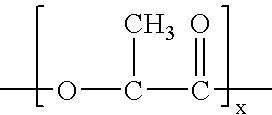Biodegradable Packaging Film
a packaging film, biodegradable technology, applied in the direction of packaging, conductive materials, synthetic resin layered products, etc., can solve the problems of high disposal cost, lack of environmental safety, and inability to biodegrade synthetic polymers
- Summary
- Abstract
- Description
- Claims
- Application Information
AI Technical Summary
Problems solved by technology
Method used
Image
Examples
examples 1-3
[0063]A ZSK-30 Twin Screw Extruder (manufactured by Werner & Pfleider, Ramsey, N.J.) was used to melt compound various blends of ECOFLEX® F BX 7011 (BASF), thermoplastic starch derived from corn (“TPS”), and PLA 4030D (polylactic acid, BASF) in the following weight ratios (ECOFLEX® / TPS / 4030D): 54 / 36 / 10; 51 / 34 / 15; and 48 / 32 / 20. The resulting strands were pelletized and then cast into films using a Haake lab-scale film casting unit. The specific compositions, compounding conditions, and film casting parameters for each blend are shown in Tables 1-3 below. The extruder temperatures varied slightly between blends for both compounding and film casting.
TABLE 1Film ContentThermo-Ratio ofplasticPLADuctileECOFLEX ®Starch4030DFillerto StiffExample(wt. %)(wt. %)(wt. %)(wt. %)ComponentsControl604000—154361009.00251341505.67348322004.00
TABLE 2Compounding ConditionsScrewMeltExtruder Conditions (° C.)SpeedTorqueTemp.ExampleZone 1234567(rpm)(%)(° C.)Control140150155155155150140150 96-10016011501601...
examples 4-5
[0066]A ZSK-30 Twin Screw Extruder (manufactured by Werner & Pfleider, Ramsey, N.J.) was used to melt compound various blends of ECOFLEX® F BX 7011 (BASF), thermoplastic starch derived from corn (“TPS”), and Omya Carb 2sst calcium carbonate (Omya Inc.) in the following weight ratios (ECOFLEX® / TPS / calcium carbonate): 54 / 36 / 10 and 48 / 32 / 20. The resulting strands were pelletized and then cast into films using a Haake lab-scale film casting unit. The specific film content, compounding conditions, and film casting parameters for each blend are shown in Tables 5-7. The extruder temperatures varied slightly between blends for both compounding and film casting.
TABLE 5Film ContentThermo-Ratio ofplasticPLADuctile toECOFLEX ®Starch4030DFillerStiffExample(wt. %)(wt. %)(wt. %)(wt. %)ComponentsControl604000—454360109.00548320204.00
TABLE 6Compounding ConditionsScrewMeltExtruder Conditions (° C.)SpeedTorqueTemp.ExampleZone 1234567(rpm)(%)(° C.)Control14015015515515515014015096-100160415016018018018...
examples 6-7
[0069]A ZSK-30 Twin Screw Extruder (manufactured by Werner & Pfleider, Ramsey, N.J.) was used to melt compound various blends of ECOFLEX® F BX 7011 (BASF), thermoplastic starch derived from corn (“TPS”), and talc (Specialty Minerals) in the following weight ratios (ECOFLEX® / TPS / talc): 54 / 36 / 10 and 48 / 32 / 20. The resulting strands were pelletized and then cast into films using a Haake lab-scale film casting unit. The specific film content, compounding conditions, and film casting parameters for each blend are shown in Tables 9-11 below. The extruder temperatures varied slightly between blends for both compounding and film casting.
TABLE 9Film ContentRatio ofThermoplasticPLAFillerDuctileECOFLEX ®Starch4030D(wt.to StiffSample(wt. %)(wt. %)(wt. %)%)ComponentsControl604000—654360109.00748320204.00
TABLE 10Compounding ConditionsScrewMeltExtruder Conditions (° C.)SpeedTorqueTemp.ExampleZone 1234567(rpm)(%)(° C.)Control140152155155155150140150951596140152155155155150140150901607140152155155155...
PUM
| Property | Measurement | Unit |
|---|---|---|
| temperature | aaaaa | aaaaa |
| glass transition temperature | aaaaa | aaaaa |
| glass transition temperature | aaaaa | aaaaa |
Abstract
Description
Claims
Application Information
 Login to View More
Login to View More - R&D
- Intellectual Property
- Life Sciences
- Materials
- Tech Scout
- Unparalleled Data Quality
- Higher Quality Content
- 60% Fewer Hallucinations
Browse by: Latest US Patents, China's latest patents, Technical Efficacy Thesaurus, Application Domain, Technology Topic, Popular Technical Reports.
© 2025 PatSnap. All rights reserved.Legal|Privacy policy|Modern Slavery Act Transparency Statement|Sitemap|About US| Contact US: help@patsnap.com



